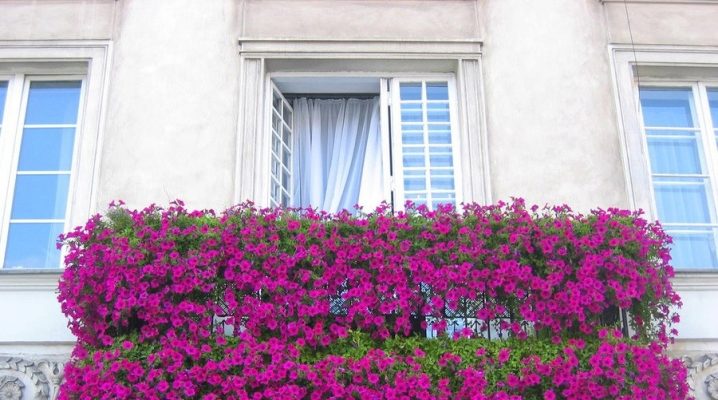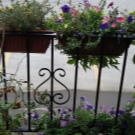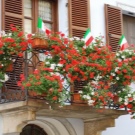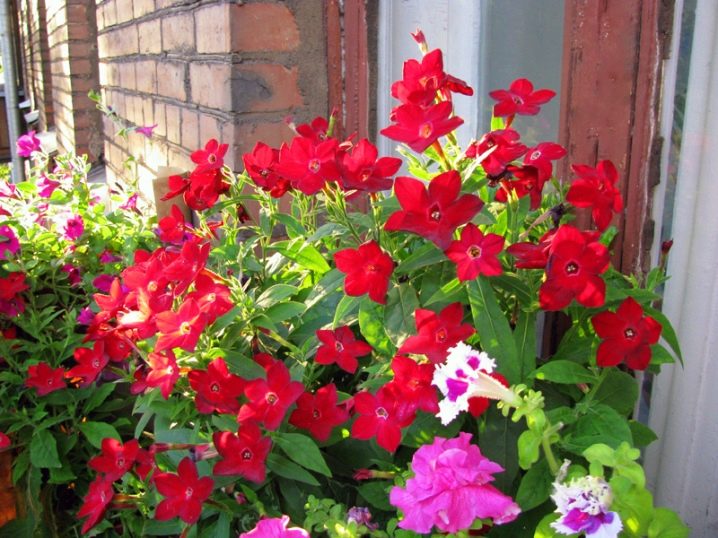Flowers for the balcony
In a stuffy city, everyone wants to have their own little green corner where you can relax after a working day. Therefore, many are trying to turn a modest balcony into a small flowered garden, where it is so nice to go out early in the morning or sit in the evening with a cup of tea.
How to start arranging a flower bed?
Before you start creating a flower garden, you need to make preliminary work:
- Release the balcony. If you need to make cosmetic repairs - put in order the sides, the floor, the fence.
- Decide what you plan to do - a green arbor, a lush flower bed, create a real jungle, or limit the planting of several flowering bushes. You will have hanging outside drawers or you will break a small garden in one corner.
- Make a plan for future composition. Install lanes, vases, boxes, fill them with drainage and earth. Land can be selected special for each species or purchase universal in the flower shop. It is better to use large claydite or crushed stone as drainage.Do not forget to purchase mineral fertilizers and study the schedule of introduction of top dressing.
Features of balcony flowers
Balcony flowers have their own specific features, which distinguish them not only from houseplants, but also from country or lawn plants.
- They should have a small root system that “economically” consumes resources, because in a modest space it is difficult to place large and deep drawers;
- Low elevated part. Too tall plants in small boxes do not look very aesthetically pleasing, and they can also be blown away by the wind;
- Long and abundant flowering. It is much nicer when the balcony is decorated with bright, fragrant heads and buds than with just green stems;
- Resistance to temperature changes. If only you do not plan to bring pots back into the apartment every evening, then it is better to choose non-capricious species.
Planting a flower bed can begin to plan in February and early March, as the future seedlings for some species need to start planting at this time. Pick up plants that bloom at different times. For example, petunias bloom in June and bloom until August, and marigolds bloom in July and bloom until the first frost.Thus, some species will always bloom and the composition will not disappear.
Tips for choosing
So, what copies you can choose for your garden, depends on your climate zone and balcony area.
If you have a small area for creativity, it is better to carry out vertical gardening. For this fit various climbing species. Install frames for them, stretch the ropes and soon you will have your own green arbor.
On the elongated area is better to do horizontal gardening. Amppelnye plants, that is hanging down from pots and flowerpots downwards, will look very beautiful.
Among the names of flowers for the balcony are the most common annuals - marigolds, petunias, nasturtiums and many others, since they are the most practical for these purposes. Annuals are not whimsical in care and bloom from early summer until the first frost. In early autumn, you can collect seeds from them and plant them next year without fear that the plants will not survive the winter.
On the northern balcony it is better to plant species that are undemanding to a lot of sunlight, such as fuchsia, nasturtium, petunia, cyclamen.The southern side is preferable to semi-succulents and light-loving plants - geranium, stonecrop, sweet pea, zinnia, purslane.
Curly
Echinocystis lobed. One of the most unpretentious climbing plants, known to all since childhood. It is suitable for growing on a balcony with any level of illumination. Large soft leaves create a pleasant shade, and white tassels of flowers have an unobtrusive honey aroma. This is a great option for novice gardeners, just trying their hand.
Decorative bindweed. All summer they will delight you with flowers — gramophone notes of various colors. Pale pink field bindweed, pale blue bindweed small, pale lilac bindweed Moorish and other species together will make an excellent composition.
Morning glory. Its various varieties are very popular, as they grow very quickly, forming a beautiful green carpet, and large flowers of rich blue and purple tones delight the eye from May to September.
Hop. A perennial plant with large, dissected rough leaves, giving a thick shadow. Pale green flowers-cones have a honey aroma and have many medicinal properties.
Ampelnye
Nasturtium. Broad-leaved ampelous plant with large orange-red flowers. Prefers the shadow side. There are more than 80 annual and biennial species.
Petunia. Differs in long, plentiful blossoming and a gentle smell. The color varies from pale pink to bright blue and purple. There are also terry species, different from the usual multi-petal, large heads. In areas with a cold climate, it is better to pre-grow petunia through seedlings.
Lobelia. Experienced gardeners prefer to plant loin at the dacha erinus, but for a balcony composition it is better to choose lobelia hanging. This plant with thin, branched stems, during flowering, completely covered with small flowers of white, purple or pink color.
Gardening
Boxwood A great option for creating green borders. Boxwood is an evergreen perennial of the shrub type. With the onset of cold weather, it is recommended to bring it into a warm place. In park culture, boxwood is used to create green figures. In apartment conditions, constant cutting is required so that the bush does not grow and does not lose its shape.
Juniper and thuja.These evergreen perennial conifers love the sunny side. They are convenient because they grow very slowly (3-5 cm per year) and do not require frequent transplants, but they like fertilizer from mineral fertilizers. Their crown is rather plastic and can be given any shape. The upper part tolerates negative temperatures, but it is better to cover the pots for winter with polystyrene so that the roots do not freeze.
The balcony is an excellent place for growing dwarf conifer trees, mainly different types of pines. You can purchase dwarf species in special nurseries, or try your hand at the art of bonsai. Experts advise to start with pine ordinary and be patient for several years to come, because this process is very slow.
Undersized
Marigold. Stunted, up to 20 cm in height, branchy plants with large orange or yellow heads, with a spicy aroma. Bloom from mid-summer to the first frost and tolerate drought. Perhaps as sowing seeds, and planting through seedlings.
Zinnia Annual or perennial plant with large, multi-petal, bulky flowers of various colors - white, red, yellow, orange. It blooms from August to the first cold weather. Loves sunshine and humus-rich soil.Some species can reach a height of 90 cm, but for the balcony it is recommended zinia-midget - a height of not more than 30 cm. Zinia-midget is blooming so luxuriantly that its green part is almost invisible. Requires pre-growing seedlings.
Pansies or Viola. These perennials will delight you with their exotic colors for a long time, while completely unpretentious to the conditions of growth. The plant is low - 15-20 cm, strongly branched, and with a tight fit forms a continuous bright, colorful carpet.
Also to the undersized, luxuriantly flowering species are Chinese carnation, daisy, fuchsia, geranium, verbena and many others.
Succulents
Purslane. Creeping annual plant, popularly known as the "mat". This name he received for lush flowering from June to September and the bright colors of flowers. Portulak is very light-requiring, but otherwise completely unpretentious in the care. It has many medicinal properties.
Ochitki. The stonecrop family is very diverse. Among them are lush blooming annuals, for example, Sedum visible with bright pink hats of flowers or hybrid stonecrop - creeping appearance with yellow panicles.There are also perennial representatives with branching stems and fleshy thick leaves - red-stone sedum and Adolf sedum. Morgan's Sedum is an ampelous plant with small red panicles of flowers.
Plants for aroma
Often, in the process of “domestication” and cultivation, plants lose their strong natural aroma, and so it turns out that beautiful, bright flowers smell almost nothing. If you want a wonderful scent to come to you from the balcony to the apartment in the evening, then try to drop mattiola, left and decorative tobacco.
Mattiola flowers are pale and inconspicuous, curl up into a tube during the day, but at dusk they open, exuding a tart, slightly bitter smell. Levka is a relative of Mattiola, but, unlike her, he has magnificent flowers - long brushes of white, purple and crimson tones.
Red and white tobacco stars begin to smell after sunset. It can bloom almost until October, but it is very picky about the conditions - it needs a lot of light, abundant watering and well-fertilized soil.





















































































